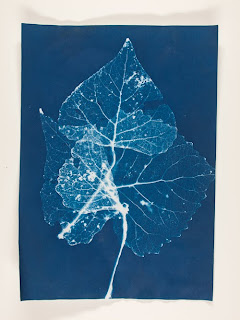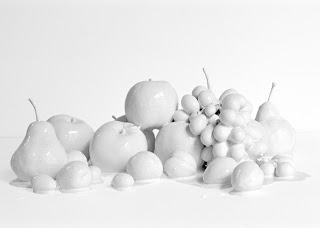Cyanotype
 |
| Cyanotype |
Cyanotype is a
photographic printing process that gives a
cyan-blue print. The process was popular in engineering circles well into the 20th century. The simple and low-cost process enabled them to produce large-scale copies of their work, referred to as
blueprints.
A positive image can be produced by exposing it to a source of
ultraviolet light (such as sunlight) with a negative. The UV light
reduces the iron(III) to iron(II). This is followed by a complex reaction of the iron(II) complex with ferricyanide. The result is an insoluble, blue dye (ferric ferrocyanide) known as
Prussian blue.
Upon exposure to ultraviolet light (such as that in sunlight), the iron in the unexposed areas will reduce, turning the paper a steel-grey-blue color. The extent of color change is dependent on the amount of UV light, but acceptable results are usually obtained after 10-20 minute exposures on a dark, gloomy day. The highlight values should appear overexposed as the water wash will reduce the final print values. Prints can be made with large format
negatives and
lithography film, or everyday objects can be used to make
photograms.
After exposure,
developing of the picture involves the yellow unreacted iron solution being rinsed off with running water. Although the blue color darkens upon drying, the effect can be accelerated by soaking the print in a 6% (v/v) solution of 3% (household)
hydrogen peroxide. The water-soluble iron(III) salts are washed away, while the non-water-soluble Prussian blue remains in the paper. This is what gives the picture its typical blue color.
VanDyke
Van Dyke Brown is an early photographic printing process. The process was so named due to the similarity of the print color to that of a brown oil paint named for Flemish painter
Van Dyck.
 |
| VanDyke Print |
Printing with Van Dyke Brown requires the use of a large format negative in the size of the desired print, a suitable substrate for coating and subsequent printing, and a UV light source, either sunlight or suitable bulbs. The substrate can be almost anything that the solution will adhere to. Watercolor paper is a good first choice, but trickier substrates such as metal, glass or tile can be first 'sized' with gelatin or arrowroot to facilitate coating. The substrate is coated with solution under tungsten light, air dried, and coated a second time if desired for a stronger image.
The negative is placed on the thoroughly dried coated substrate, and is then weighted with a piece of glass. Frequent printers often use a printing frame to ease the checking of printing progress without disturbing the registration, or alignment, of the negative on the paper. These printing frames also ease the printing of a second coat over the same image.
Lumin
.jpg) |
| Lumin Print by Angel Pei |
“Lumen” is understood as the projection of light radiating from one ominous source, i.e. sunlight, or UV light. This is particularly pertinent to this method of printing as it utilizes available light (daylight) as opposed to controlled light (enlarger exposure light, or the rapid on/off light when creating photograms) in order to print an image.
Lumen Printing is also an alternative to printing contact prints or photograms, again requiring minimum time, equipment and money. This is a black and white photographic process, although with that in mind, you will be surprised by the results (and colour) of your creations. That is the beauty of photography.
Alternative Processes Site





.jpg)
